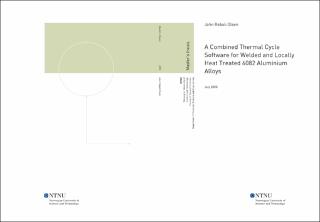| dc.description.abstract | Denne oppgaven dekker utviklingen av et kombinert termisk syklus-program for sveising og induksjon, Combined Weld and Induction Thermal Cycle software, som brukes til å estimere de termiske syklusene under sveising og lokal varmebehandling etter sveising, LPWHT, ved induksjonsoppvarming av 6082.50-T6 aluminium. Programmet, Combined Weld and Induction Thermal Cycle software, er utviklet i MatLab R2017b ved implementering av analytiske modeller som beskriver de termiske syklusene for sveising og lokal varmebehandling. Den lokale varmebehandlingen etter sveising har som mål å manipulere geometrien til den varmepåvirkede sonen, HAZ, etter sveising av 6082.50-T6 aluminiumkonstruksjoner, for å øke de strukturelle egenskapene. Til slutt blir de termiske syklusene brukt som input til et program for presipitering, flytespenning og arbeidsherding, NaMo, som estimerer de resulterende mekaniske egenskapene etter sveising og LPWHT.
Det utviklede programmet ble kalibrert basert på eksperimentelle data, både fra denne oppgaven og den foregående, og viser en god overensstemmelse med eksperimentelle data. Nettoeffekten for induksjonsoppvarmingen ble bestemt til 1898 W og virkningsgraden lik 0,251, med en diskret varmekildefordeling. Estimatene gjort av det utviklede programmet og NaMo, indikerer at en manipulering av HAZ er mulig. Etter sveising og LPWHT, fulgt av en romtemperaturlagring, RT-storage, på 14 dager, har den estimerte laveste hardheten i HAZ blitt noe redusert. En varmebehandling etter sveising, PWHT, og LPWHT økte den estimerte laveste hardheten med mellom 8,7-31,4 % ved overflaten, mens den estimerte laveste hardheten i midten av tykkelsen på materialet ble redusert. En varmebehandling etter sveising og LPWHT indikerer at ideen om en LPWHT, kan øke de strukturelle egenskapene til sveisede 6082.50-T6 aluminiumkonstruksjoner. | |
| dc.description.abstract | This paper covers the development of a Combined Weld and Induction Thermal Cycle software used to estimate the thermal cycles during welding and local post weld heat treatment, LPWHT, by induction heating of 6082.50-T6 aluminium. The Combined Weld and Induction Thermal Cycle software is developed in MatLab R2017b by implementation of analytical models which describe the thermal cycles of welding and LPWHT. The LPWHT by induction heating aims to manipulate the geometry of the heat affected zone, HAZ, after welding of 6082.50-T6 aluminium structures, to increase the structural properties. Lastly, the thermal cycles are used as input to a precipitation, yield strength and work-hardening software, NaMo, which estimates the resulting mechanical properties after welding and LPWHT.
The developed software was calibrated based on experimental data, from both this study and a preceding one, and shows a good correspondence with the experimental data. The net power for the induction heating was found to 1898 W and the efficiency equal to 0.251, with a discrete partial heat source distribution. Predictions indicate that a manipulation of the HAZ is possible. After welding and LPWHT, followed by a room temperature storage, RT-storage, of 14 days, the predicted lowest hardness in the HAZ has slightly decreased. A post weld heat treatment, PWHT, after welding and LPWHT increased the predicted lowest hardness by between 8.7-31.4 % at the surface, while the predicted lowest hardness at the center of the thickness of the material was slightly reduced. The addition of a PWHT indicates that the methodology of a LPWHT could increase the structural properties of welded 6082.50-T6 aluminium structures. | |
